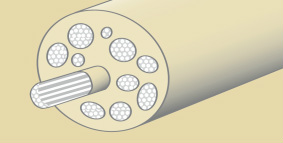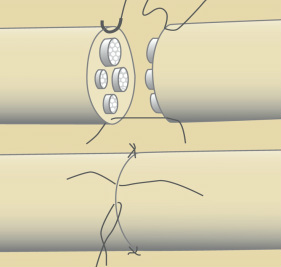MAKE AN APPOINTMENT TODAY!
Nerve Injury
Nerve Injury TreatmentTo fix a cut nerve, the insulation around both ends of the nerve is sewn together. A nerve in a finger is only as thick as a piece of thin spaghetti, so the stitches have to be very tiny and thin. The repair may need to be protected with a splint for the first 3 weeks to protect it from stretching apart since it is so delicate. The goal in fixing the nerve is to repair the outer cover so that nerve fibers can grow down the empty tubes to the muscles and sensory receptors and work again (see Figure 2). The surgeon tries to line up the ends of the nerve repair so that the fibers and empty tubes match up with each other as best as possible, but with millions of fibers in the nerve, not all of the original connections are likely to be re-established. If a wound is dirty or crushed, your physician may wait to fix the nerve until the skin has healed. If there is a gap between the ends of the nerve, the doctor may need to take a piece of nerve (nerve graft) from another part of the body to fix the injured nerve. This may cause permanent loss of feeling in the area where the nerve graft was taken. Smaller gaps can sometimes be bridged with “conduits” made from a vein or special cylinder.
Once the nerve cover is fixed, the nerve fibers generally begin to start growing across the repair site after three or four weeks. The nerve fibers then usually grow down the empty nerve tubes up to one inch every month, depending on the patient’s age and other factors. This means that nerve injury in the arm 11 or 12 inches above the fingertips, it may take as long as a year before feeling returns to the fingertips. The feeling of pins and needles in the fingertips is common during the recovery process. While this can be uncomfortable, it usually passes and is a sign of recovery. Nerve RehabilitationThe patient should be aware of several things while waiting for the nerve to heal. Your doctor may recommend therapy to keep joints flexible. If the joints become stiff, they will not work even after muscles begin to work again. When a sensory nerve injury occurs, the patient must be extra careful not to burn or cut their fingers since there is no feeling in the affected area. After the nerve has recovered, the brain gets “lazy,” and a procedure called sensory re-education may be needed to improve feeling to the hand or finger. Your doctor will recommend the appropriate therapy based on the nature of your injury. Factors that may affect results after nerve repair include age, the type of wound and nerve, and location of the injury. While a nerve injury may create lasting problems for the patient, care by a physician and proper therapy help return to more normal use.
Reproduced with permission from the American Society for Surgery of the Hand www.handcare.org
|
Ask Dr. Izadi
Wide Awake Hand Surgery Most hand and wrist conditions including fractures can be treated under local anesthesia.
Learn More
Second Opinion Your peace of mind is invaluable and getting a second opinion is easy.
Learn More
Where Does It Hurt? Not sure what your symptoms mean? This interactive tool may help you.
Learn More

Dr. Izadi in the News Blog |
Disclaimer and Privacy
IZADIHAND.COM © 2011-2022 Kayvon David Izadi MD - All Rights Reserved
Webmaster
IZADIHAND.COM © 2011-2022 Kayvon David Izadi MD - All Rights Reserved
Webmaster



